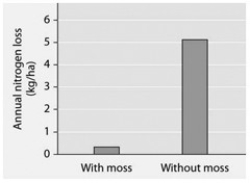Multiple Choice
Researchers tested nitrogen loss from soil where the moss Dawsonia was growing and compared it to soil from which Dawsonia had been removed. The data are presented in the accompanying figure. 
-If the actual results most closely resembled those in part (A) in the figure above, then a further question arising from these data is: "Do the Dawsonia rhizoids have to be alive to reduce soil nitrogen loss, or do dead rhizoids have the same effect?" Arrange the following steps in the correct sequence to test this hypothesis.
1) Add metabolic poison to the soil of the experimental plot of mosses.
2) Apply water equally to the experimental and control plots.
3) Measure initial soil nitrogen contents of control and experimental plots.
4) Determine nitrogen loss from the soil of control and experimental plots.
5) Establish two identical plots of Dawsonia mosses; one as a control, the other as the experimental treatment.
A) 5 → 1 → 3 → 2 → 4
B) 5 → 2 → 3 → 1 → 4
C) 5 → 3 → 1 → 2 → 4
D) 4 → 5 → 1 → 3 → 2
E) 5 → 3 → 2 →? 1 → 4
Correct Answer:

Verified
Correct Answer:
Verified
Q9: A botanist discovers a new species of
Q10: Because they are morphologically simple, Psilotophyta (whisk
Q15: According to our current knowledge of plant
Q17: Red, brown, and some green algae exhibit
Q18: Which group of seedless vascular plants was
Q19: What is TRUE about the genus Sphagnum?<br>A)
Q36: Which of these are spore-producing structures?<br>A) sporophyte
Q78: Which set contains the most closely related
Q86: Which structure is common to both gymnosperms
Q100: Entrepreneurs attempted, but failed, to harvest nuts